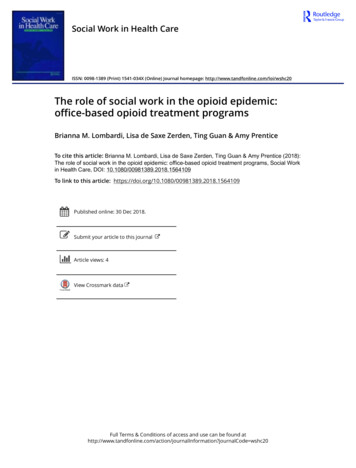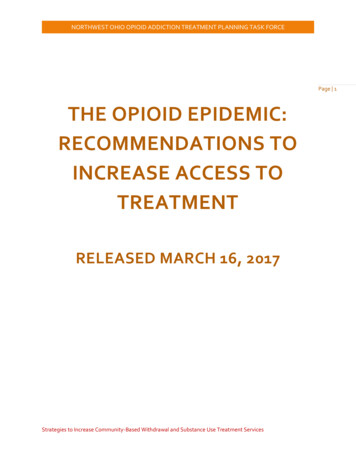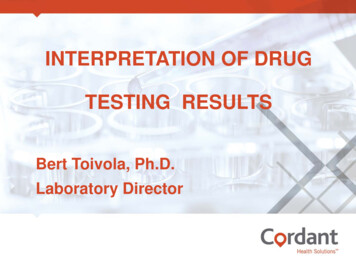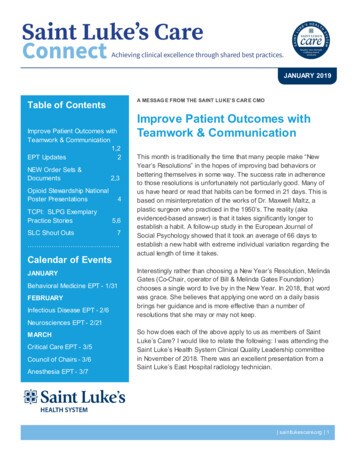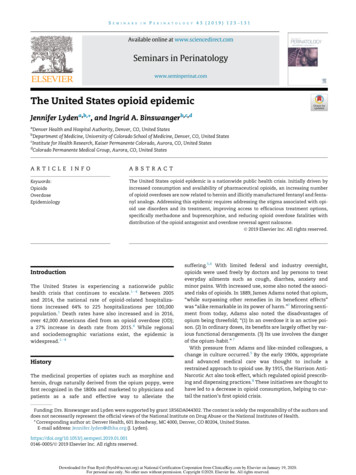
Transcription
TAGEDENSE M I N A R SI NPE R I N A T O L O G Y43 (2019) 123131Available online at www.sciencedirect.comSeminars in Perinatologywww.seminperinat.comThe United States D6X Xopioid D7X XepidemicD8X XJennifer LydenDa,b,9X X *, and D10X XIngrid A. BinswangerD1Xb,c,dXaDenver Health and Hospital Authority, Denver, CO, United StatesDepartment of Medicine, University of Colorado School of Medicine, Denver, CO, United StatescInstitute for Health Research, Kaiser Permanente Colorado, Aurora, CO, United StatesdColorado Permanente Medical Group, Aurora, CO, United StatesbA R T I C L E I N F OAB STR ACTKeywords:The United States opioid epidemic is a nationwide public health crisis. Initially driven byOpioidsincreased consumption and availability of pharmaceutical opioids, an increasing numberOverdoseof opioid overdoses are now related to heroin and illicitly manufactured fentanyl and fenta-Epidemiologynyl analogs. Addressing this epidemic requires addressing the stigma associated with opioid use disorders and its treatment, improving access to efficacious treatment options,specifically methadone and buprenorphine, and reducing opioid overdose fatalities withdistribution of the opioid antagonist and overdose reversal agent naloxone.Ó 2019 Elsevier Inc. All rights reserved.IntroductionThe United States is experiencing a nationwide publichealth crisis that continues to escalate.1 4 Between 2005and 2014, the national rate of opioid-related hospitalizations increased 64% to 225 hospitalizations per 100,000population.1 Death rates have also increased and in 2016,over 42,000 Americans died from an opioid overdose (OD);a 27% increase in death rate from 2015.4 While regionaland sociodemographic variations exist, the epidemic iswidespread.1 4HistoryThe medicinal properties of opiates such as morphine andheroin, drugs naturally derived from the opium poppy, werefirst recognized in the 1800s and marketed to physicians andpatients as a safe and effective way to alleviate thesuffering.5,6 With limited federal and industry oversight,opioids were used freely by doctors and lay persons to treateveryday ailments such as cough, diarrhea, anxiety andminor pains. With increased use, some also noted the associated risks of opioids. In 1889, James Adams noted that opium,“while surpassing other remedies in its beneficent effects”was “alike remarkable in its power of harm.”7 Mirroring sentiment from today, Adams also noted the disadvantages ofopium being threefold; “(1) In an overdose it is an active poison. (2) In ordinary doses, its benefits are largely offset by various functional derangements. (3) Its use involves the dangerof the opium-habit.” 7With pressure from Adams and like-minded colleagues, achange in culture occurred.5 By the early 1900s, appropriateand advanced medical care was thought to include arestrained approach to opioid use. By 1915, the Harrison AntiNarcotic Act also took effect, which regulated opioid prescribing and dispensing practices.8 These initiatives are thought tohave led to a decrease in opioid consumption, helping to curtail the nation’s first opioid crisis.Funding: Drs. Binswanger and Lyden were supported by grant 1R56DA044302. The content is solely the responsibility of the authors anddoes not necessarily represent the official views of the National Institute on Drug Abuse or the National Institutes of Health.* Corresponding author at: Denver Health, 601 Broadway, MC 4000, Denver, CO 80204, United States.E-mail address: Jennifer.lyden@dhha.org (J. 010146-0005/Ó 2019 Elsevier Inc. All rights reserved.Downloaded for Fran Byrd (fbyrd@nccnet.org) at National Certification Corporation from ClinicalKey.com by Elsevier on January 19, 2020.For personal use only. No other uses without permission. Copyright 2020. Elsevier Inc. All rights reserved.
124SE M I N A R SI NPE R I N A T O L O G YAs foreshadowed at the turn of the twentieth century, themodern-day epidemic has also been closely linked toincreases in opioid consumption and liberal prescribing practices by clinicians.9 11 Starting largely in the 1980s, attitudestoward pain management and opioid safety began to shift.Previously, these medications had been reserved for severecancer pain, end-of-life care and limited episodes of acutepain. However, pain specialists and patient advocacy groupsbegan to raise awareness of the inadequate treatment of noncancer pain and underutilization of pharmaceutical opioids.For example, in 1985 an editorial published in Advances inAlcohol and Substance Abuse reported that physicians“markedly undertreat” pain and expressed concern for“opiophobia”an “irrational and undocumented” fear thatpatients will become addicted to opioids when opioids areused appropriately.12 This sentiment was echoed by the President of the American Pain Society (APS) in a published editorial that advocated for improved pain control and encourageduse of opioids to achieve this, writing “therapeutic use of opiate analgesics rarely results in addiction”.13 What followedwas a movement by the APS to focus on pain and pain control; referring to it as the “fifth vital sign” necessitatingrepeated monitoring and intervention.11,14 The Joint Commission (formerly The Joint Commission on the Accreditation ofHealthcare Organizations) also intervened and in 2001 setnew pain management standards, which tied healthcarequality and patient satisfaction to pain control.11,14,15Reports of pharmaceutical opioid safety often cited a oneparagraph letter published in the New England Journal ofMedicine in 1980.16 In this correspondence, the authors brieflyreported findings from a retrospective, observational studythat assessed the side effects of opioids in hospitalizedpatients. This limited information was frequently used tohighlight safety and promote increased prescribing by clinicians for chronic, non-cancer pain. For example, promotionalvideo conferences and training sessions produced and fundedby large pharmaceutical companies, and targeted towardphysicians, inaccurately reported the risk of addiction as “lessthan one percent”.17Compounding this, in 1995 the new extended-release (ER)oxycodone was approved by the Food and Drug Administration (FDA) for use and marketed to physicians as a safe andeffective opioid pain reliever. The extended release formulation, it was argued, provided a slow, sustained release of medication which posed a lower risk for a “high” when comparedto immediate release opioids.18,19 Marketing campaignsseized on this theory, promoting ER oxycodone as an abusedeterrent formulation with very low risk for iatrogenic addiction.17 At the time however, there were little data to supportthis claim.17,20 Studies have since shown that ER oxycodonehas a similar efficacy and safety profile as immediate releaseopioid pain relievers21 23 and in 2001, the FDA required thatthis claim be removed from drug labeling.24Paralleling the increased attention to pain managementand widespread marketing campaigns, opioid prescribingincreased, peaking at 225 millionD12X Xprescriptions dispensed anda rate of 81.2 prescriptions per 100 persons in 2010.25 In conjunction, diversion and non-medical use (i.e., the use of pharmaceutical opioids without a prescription or in a way thatwas not intended by the prescribing clinician) also43 (2019) 123131increased,26 28 and between 1999 and 2009 death rates involving pharmaceutical opioids increased nearly fourfold.29After a period of stabilization, opioid prescribing ratesbegan declining in 2012 and have declined each year from2012 to 2017.30 Nonetheless, due in large part to upsurges infatal overdoses involving heroin and more recently, illicitlymanufactured fentanyl (IMF) and highly potent fentanyl analogues, opioid overdose deaths continue to rise.4,31Distinctions between tolerance,D13X XD14X Xdependence,andD15XopioidXD16X XuseD17X XdisorderAn opioid is any substance that binds to opioid receptors inthe central nervous system. Opioids can be (1) endogenous,i.e. endorphins, (2) naturally occurring opium alkaloidsderived directly from the opium poppy, or (3) semi-syntheticor synthetic compounds. Naturally occurring opioids such asmorphine and codeine may also be referred to as opiates. Heroin, which is made from morphine, and oxycodone, areexamples of semi-synthetic opioids. Fully synthetic opioids,such as methadone and fentanyl, have chemical structuresdifferent than opium alkaloids but bind to the same opioidreceptors in the central nervous system, triggering similaranalgesic and euphoric effects.Although opioid tolerance, dependence and opioid use disorder (OUD) represent distinct phenomena with markedly different clinical implications, their relationship is oftenmisunderstood.32 Opioid tolerance and dependence are anticipated, physiologic adaptations in the body that occur withrepeated meaningful doses of opioid substances, either pharmaceutical or illegal. Tolerance, defined as a diminishedresponse to a substance that occurs with frequent use, oftenrequires that patients use increasing opioid doses to achievean equivalent analgesic response.33,34 Dependence meansthat a person may experience signs or symptoms of withdrawal when their dose is decreased or stopped abruptly.33,34Theses responses are not unique to opioids and may occurwith other medications or substances such as antihypertensive medications, corticosteroids or even caffeine.Unlike tolerance and dependence, OUD is not an anticipated or adaptive response to repeated opioid exposure.33The hallmark of a use disorder is a problematic pattern ofbehavior characterized by intense “cravings” that contributeto “compulsive drug seeking and use, despite harmful consequences.”35 The diagnostic criteria for OUD are outlined inthe Diagnostic and Statistical Manuel of Mental Disorders(DSM), Fifth Edition36 (Table 1). This diagnosis replaces theseparate previous diagnoses from DSM-IV of “substanceabuse” and “substance dependence”.37Similar to other substance use disorders, OUD is a complexdisease not fully understood by clinicians and researchers.While there are numerous ways to conceive and understandaddiction in light of individual and social factors, addiction iscommonly understood to be disease of the brain where recurrent exposure to a substance alters its structure and function,ultimately contributing to the compulsive drug-seekingbehavior cardinal to OUD.38,39 However, not all people whoare exposed to opioids will develop an OUD.32 Genetic, environmental and social factors interact to make some patientsDownloaded for Fran Byrd (fbyrd@nccnet.org) at National Certification Corporation from ClinicalKey.com by Elsevier on January 19, 2020.For personal use only. No other uses without permission. Copyright 2020. Elsevier Inc. All rights reserved.
TAGEDENSE M I N A R SI NPE R I N A T O L O G YTable 1 – DSM V diagnostic criteria for opioid usedisorder.36Two or more of the following within a 12-month period: Using larger amounts of opioids or over a longer period of time thanwas intended Persistent desire to cutback or unsuccessful efforts to control use Substantial amount of time spent obtaining, using or recovering fromuse Craving or strong desire to use opioids Failure to fulfill obligations at work, home or school due to use Continued use despite recurrent social or interpersonal problemscaused or exacerbated by use Giving up or reducing social, occupational or recreational activitiesdue to use Recurrent opioid use in situations that may be physically dangerous Continued use despite knowledge of having a physical or psychological problem caused or exacerbated by opioids Tolerance* Development of withdrawal syndrome if use stopped*Opioid use disorder severity: Mild 2-3 symptoms or signs Moderate 4-5 symptoms or signs Severe 6 or more symptoms or signs* Tolerance and withdrawal criteria not met if opioids only used undermedical supervision and as intended.more vulnerable than others. Further, some medicalcomplications of OUD are the result of limited access toeffective preventive strategies, such as sterile syringes,which result from legal policies rather than purely biologicalphenomena.40,41OUD is often compared to chronic diseases such diabetesand heart disease, where daily medication and lifestyle modification are needed to improve symptoms (e.g. cravings) andreduce adverse health outcomes (e.g. HIV, hepatitis C, overdose).42,43 Similar to other chronic diseases, treatment adherence is often imperfect and recurrence of use can becommon.Neonatal abstinence syndrome (NAS) is a postnatal withdrawal syndrome that is closely linked to OUD. Strictly speaking, NAS refers to withdrawal syndromes in neonates causedby any substance, however, with the increasing incidence offetal opioid exposure in-utero, NAS commonly refers to neonatal opioid withdrawal.44 46 For infants with consistent prenatal opioid exposure of any kind, it is an expected andmanageable outcome. Prenatal opioid exposure includeschronic pharmaceutical opioid therapy under a doctor’ssupervision for severe pain, methadone or buprenorphinepharmacotherapy for OUD or illicit use of substances such asheroin.Misunderstandings about NAS are common. For instance,infants who develop NAS are not born “addicted” to opioids.47The cardinal feature of addiction is a problematic pattern ofbehavior, which is not possible in neonates. There is also acommon misperception that higher maternal opioid dosesare tied to the onset and severity of NAS. However, severalstudies have examined the relationship between methadonedose and the incidence and severity of NAS with mixedresults.48 50 When restricted to prospective studies using anobjective scoring system, a meta-analysis by Cleary etD18X X al.found no statistical difference in the incidence and severity ofNAS by methadone dose.51 This suggests that other factors43 (2019) 123131125should be considered when determining maternal methadone during pregnancy, such as adequate control of withdrawal symptoms and relapse risk.Both methadone and buprenorphine can be used to treatwomen with OUD during pregnancy. A multicenter, doubleblind randomized control trial, the Maternal Opioid Treatment; Human Experimental Research (MOTHER) study, examined neonatal outcomes in pregnancies with maternalexposure to methadone or buprenorphine.52 Investigatorsdemonstrated that, while there was no difference in the number of infants requiring treatment for NAS between thegroups, buprenorphine pharmacotherapy was associatedwith lower morphine requirements, shorter duration of NAStreatment, and shorter infant hospital stays. This study suggested less severe NAS with buprenorphine treatment whencompared to methadone. Similarly, a 2013 Cochrane review,which included the MOTHER study, also suggested less severeNAS with buprenorphine. However, the authors also reportedincreased treatment retention in those receiving methadonecompared to buprenorphine. Citing variation across outcomes, as well as the small body of evidence, the authors concluded there was insufficient evidence to support onetreatment over the other.53EpidemiologyAccording to the National Survey on Drug Use and Health, anational, population-based household survey, in 2016,11.8 millionD19X XAmericans 12 or older reported misuse of opioids(i.e., non-medical use of pharmaceutical opioids or use of heroin) in the last year. Of these, 92% misused pharmaceuticalopioids only, 5.4% misused pharmaceutical opioids and heroin and 2.6% used heroin only.54In 2016, over 42,000 Americans died from an opioid overdose, representing a 27% increase in death rates from opioid overdoses from 2015 (13.3 per 100,000 population).4Heroin, IMF and highly potent fentanyl analogs are nowimplicated in the majority of fatal opioid overdoses. TheCenters for Disease Control and Prevention (CDC) estimatethat over 80% of the opioid overdose deaths in 2016 involvedheroin or a synthetic opioid other than methadone (i.e.,fentanyl).55 Between 1999 and 2016, the rate of deathsinvolving heroin increased seven-fold (from 0.7 per 100,000in 1999 to 4.9 in 2016) and the rate of deaths involving synthetic opioids increased twenty-fold (from 0.3 per 100,000in 1999 to 6.2 per 100,000 in 2016). This includes a100% increase in synthetic opioid overdose death ratesfrom 2015 to 2016.55Historically, men have been disproportionately affected byopioids with higher overall rates of OUD and overdose mortality than women, however the prevalence of OUD and its complications are rising in women.3 Between 2005 and 2014,opioid-related hospitalizations increased for both men andwomen. However, rate increases were more for women thanfor men (75% vs 55%) and by 2014, in most states, the rate ofopioid-related inpatient stays for women exceeded that ofmen.1Mirroring increases in the general population, opioid useand OUD in women who are pregnant have increased.56 59Downloaded for Fran Byrd (fbyrd@nccnet.org) at National Certification Corporation from ClinicalKey.com by Elsevier on January 19, 2020.For personal use only. No other uses without permission. Copyright 2020. Elsevier Inc. All rights reserved.
126SE M I N A R SI NPE R I N A T O L O G YBetween 1999 and 2014, the rate of antepartum opioid use disorder quadrupled (from 1.5 to 6.5 per 1000 hospital births)60and opioids are now the most common reason for seekingdrug treatment during pregnancy.61 Concurrently, the incidence of NAS increased 400% from 2000 to 2012,62,63 andnational medical costs for NAS were estimated at 316 millionD20X Xin 2012 alone.64Confronting the opioidD21X XD2X XepidemicReducing stigmaD23X XThe language used in discussing and treating patients withsubstance use disorders is important. Incorrect terminologymay unknowingly contribute to misunderstandings aboutOUD, perpetuate stigma and bolster stereotypes; collectivelyreinforcing treatment barriers for patients.65,66Studies have found that terms such as “addict” and“substance abuser” elicit strong negative feelings toward individuals suffering from OUD.67 This can imply that addictionoccurs as a fault of the person, such as a personality flaw ormoral failing, requiring punitive measures,68 rather than as aresult of a medical condition.38,39“Person first” language has been suggested as a way toaddress stigma and stereotypes in OUD.65,69 In person firstlanguage, words describing individuals precede wordsdescribing their disease or disorder.70 For example, consider“patient with a history of opioid use disorder” versus “opioidabuser” or “addict”. The former, helps to focus on the person43 (2019) 123131and not their disorder, conveying that while they may sufferfrom OUD, it is not their only identity.The language used to describe medications used to treatOUD can also be pejorative.71,72 Treatment with the opioidagonists methadone or buprenorphine is often referred to as“opioid substitution therapy” or “medication assistedtreatment”. Experts argue that this terminology supports thefalse notion that these medications are “replacing one addiction for another” and suggests that pharmacotherapy ismerely an adjunct to other aspects of addiction care.71,73 Contrary to this, the scientific literature strongly supports the useof methadone and buprenorphine as a safe and effective wayto reduce illicit drug use and improve societal engagement.74Improving prescribingD24X XD25X XpracticesAlthough prescribing rates have declined in recent years, theincreased availability and use of opioid pain medicationsplayed an important role in the modern-day epidemic. In2016, the amount of prescription opioid medications in theUnited States was roughly three times as high as in 1999,25,75and in 2016, over 17,000 died from a pharmaceutical opioidoverdose.4 Several studies have shown a temporal and spatialrelationship between the availability of pharmaceuticalopioids and overdose mortality.10,27,76,77 Even when prescribed by a physician and taken as instructed, use of pharmaceutical opioids can lead to adverse health outcomesincluding addiction and fatal overdoses.78 Evidence suggeststhat these risks are increased with long acting opioid formulations, long term opioid therapy, high morphine equivalent84Table 2 – CDC guidelinesD1X Xfor prescribingD2X XD3X Xopioidsfor chronicD4X XD5X Xpain.When to initiate or continue opioids:1. on-pharmacologic therapy and non-opioid pharmacologic therapy are preferred treatment for chronic pain. If used, opioids should be given in combi-nation with non-pharmacologic therapy and non-opioid pharmacologic therapy when appropriate.2. Realistic treatment goals should be established prior to initiating therapy.3. Before starting and periodically during treatment, clinicians should discuss risks and benefits with the patient.Opioid selection, dosing and duration:1. Immediate release opioids should be used instead of long acting opioids.2. The lowest effective dose should be prescribed.3. When treating acute pain, the lowest effective dose of immediate release opioids should be used for a limited duration; typically 3 days or less, rarelymore than 7 days.4. Clinicians should reevaluate benefits and harms with the patient 1-4 weeks after starting chronic opioid therapy and re-assess risk-benefit of medica-tion.Assessing risk and addressing harms:1 Evaluate risk factors for adverse events before initiation and during treatment. Consider naloxone for higher risk patients.2. Review prescription drug monitor program (PDMP) database before initiating and during treatment.3. Urine drug testing should be used before initiating and periodically during treatment.4. Avoid prescribing opioids and benzodiazepines together.5. Offer treatment or refer patients to treatment if opioid use disorders is expected.Downloaded for Fran Byrd (fbyrd@nccnet.org) at National Certification Corporation from ClinicalKey.com by Elsevier on January 19, 2020.For personal use only. No other uses without permission. Copyright 2020. Elsevier Inc. All rights reserved.
TAGEDENSE M I N A R SI NPE R I N A T O L O G Ydoses, concurrent benzodiazepine use, and past history ofsubstance use disorders, tobacco use, and mental healthdiagnoses.79 83In 2016 the CDC released guidelines with 12 specific recommendations (Table 2) to assist clinicians in prescribing pharmaceutical opioid medications to treat pain and recognizeand treat patients with high-risk behaviors or OUD.84 The primary focus of these recommendations pertained to medicalmanagement of pain lasting 3 months and did not pertainto cancer or end-of-life care. Acute pain management wasalso briefly addressed.Prescription drug monitoring programs (PDMP) have alsobeen established in nearly every state to improve prescribingpractices. Several states report PDMP effectiveness in processoutcomes such as improving physician confidence,85,86 identifying patients with multiple prescribers, and reducing availability of controlled substances.87 Patrick et al alsodemonstrated that state PDMP implementation was associated with a decrease of 1.12 opioid-related overdose deathsper 100,000 population annually. States that monitored fouror more drug schedules and updated their PDMP regularlyhad even great reductions in mortality rates.88 Current CDCguidelines suggest reviewing PDMP data prior to all opioidprescriptions and at minimum, prior to initiating long-termopioid therapy and periodically during its course.84Increasing utilizationD26X Xof medicationsD27X Xfor opioidD28X XD29X XuseD30X XdisorderThere are three FDA-approved medications to treat patientswith OUDD31X X methadone, buprenorphine and naltrexone. Methadone and buprenorphine are long-acting opioid receptoragonists that provide consistent systemic drug levels andhave been shown to reduce opioid cravings89 and preventwithdrawal syndromes.90 Naltrexone, an opioid receptorantagonist, is available as an oral medication requiring dailydosing or as an injectable medication requiring monthly dosing. When taken appropriately, naltrexone blocks the effectsof opioids and can prevent relapse. However, adherence todaily dosing is challenging and a 2011 Cochrane Review suggested that oral naltrexone was no better than placebo or nopharmacotherapy in preventing relapse or improving treatment retention.91 Studies investigating the efficacy ofextended-release naltrexone have been more promising;92,93however, concerns remain regarding the overdose risk inpatients treated with naltrexone only.94,95Studies have repeatedly shown that methadone and buprenorphine reduce illicit opioid use, increase retention in drugtreatment, and reduce mortality.96 101 For example, a systematic review and meta-analysis of cohort studies published inthe British Medical Journal in 2017 found that patients whoreceived maintenance buprenorphine or methadone had substantially reduced all-cause and overdose mortality rateswhen compared to patients who did not receive opioid agonist medications.102 A Cochrane review by Mattick et al in2009 and 2014 also showed that when compared to placebo,both buprenorphine and methadone were effective in retaining people in treatment.74,99Despite a substantial evidence base, agonist pharmacotherapy for OUD remains underutilized. Barriers are multifoldand include a lack of trained prescribers to initiate and43 (2019) 123131127maintain medications, misperceptions by patients and providers about how medications work and their intended outcomes and fear of stigma or criminalization by patients.Unlike methadone, which can only be dispensed bylicensed, specialty treatment programs with daily dosing, theDrug Addiction Treatment Act of 2000 (DATA 2000) allowsbuprenorphine to be prescribed by waivered physicians andadvanced practice providers in an office-based setting to treatOUD.103 Studies suggest this has improved access to pharmacotherapy for many patients with OUD; however, accessremains poor. For example, Jones et al estimated that in 2012,if all available methadone treatment slots were filled and allbuprenorphine waivered physicians saw the maximum number of patients allowed, over 900,000 patients would still be inneed of pharmacotherapy.104 This shortfall is particularly direin rural areas of the country where over half (56.3%) of allcounties lack a single buprenorphine provider.105 Patrick et alalso found that while most providers were accepting newpatients in Appalachia, providers were less likely to acceptwomen who were pregnant (91% vs 75%).In addition to problems with access, pregnant women withOUD may also face fears of criminalization when seekingpharmacotherapy to treat OUD. In 2014, Tennessee was thefirst state to pass a statute specifically allowing women to beprosecuted for assault if they engaged in illegal drug use during pregnancy. Currently, 23 states and the District of Columbia consider substance abuse during pregnancy to be childabuse and 24 states mandate healthcare workers to reportsubstance abuse if suspected.106 This legal trend is concerning considering, the data suggest that women who are pregnant and receive methadone or buprenorphine are less likelyto relapse on illicit opioids and more likely to engage in routine prenatal care,53,107 109 leading to better health outcomesfor mother, fetus and infant.Reducing fatal overdosesNaloxone, an opioid receptor antagonist, is an antidote to opioid overdoses.110 Observational studies have repeatedlyshown that take home naloxone is a safe and effective way toreduce OD mortality in patients with OUD111 114 and is notknown to lead to an increase in substance use.115,116The effectiveness of naloxone requires that overdosebystanders can (1) easily access the medication, (2) promptlyrecognize the signs and symptoms of OD and (3) effectivelyadminister a life-saving dose. As such, most states havemoved beyond traditional prescription models for distribution; allowing for third party prescriptions for anyone whomay encounter an overdose and non-patient specific prescriptions where pharmacies and community health programs may distribute naloxone to any individual and provideeducation and training on OD recognition and medicationadministration.117 Guidelines suggest that clinicians offernaloxone to patients with OUD and consider offering it topatients on chronic opioid therapy when risk factors for opioid overdose are present such as concomitant benzodiazepine use, opioid doses over 50 morphine milligramequivalents per day, history of opioid overdose or other substance use disorder.84 A risk prediction model has beenDownloaded for Fran Byrd (fbyrd@nccnet.org) at National Certification Corporation from ClinicalKey.com by Elsevier on January 19, 2020.For personal use only. No other uses without permission. Copyright 2020. Elsevier Inc. All rights reserved.
128SE M I N A R SI NPE R I N A T O L O G Ydeveloped to help providers select patients prescribed chronicopioid therapy who could benefit from naloxone.83ConclusionInitially driven by increases in the availability of pharmaceutical opioids, fatal overdoses are now largely related to theemergence of illegally manufactured fentanyl and fentanylanalogues. Mortality statistics are grim; however, researchhas consistently shown improved outcomes with the use ofpharmacotherapy to treat OUD, including for women who arepregnant. Clinicians can help reduce the stigma associatedwith OUD and barriers to treatment by using appropriate terminology that is non-judgmental and non-punitive. Theseefforts may help to address the opioid epidemic.Authors’ contributionJL wrote the manuscript and IAB critically revised the manuscript.R E F E R E N C E S1. Weiss AJ, Bailey MK, O’malley L, Barrett ML, Elixhauser A,Steiner CA. Patient Characteristics of Opioid-Related InpatientStays and Emergency Department Visits Nationally and by State,2014. www.hcup-us.ahrq.gov/faststats/landing.jsp AccessedAugust 12, 2018. M, Galea S. Worldwide preva2. Martins SS, Sampson L, Cerdalence and trends in unintentional drug overdose:
fetal opioid exposure in-utero, NAS commonly refers to neo-natal opioid withdrawal.44 46 For infants with consistent pre-natal opioid exposure of any kind, it is an expected and manageable outcome. Prenatal opioid exposure includes chronic pharmaceutical opioid therapy under a doctor's supervision for severe pain, methadone or buprenorphine


